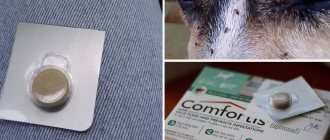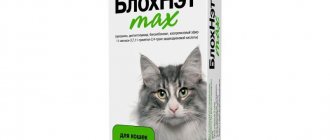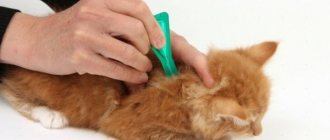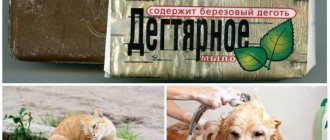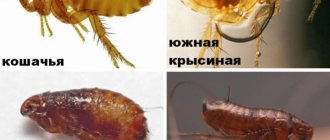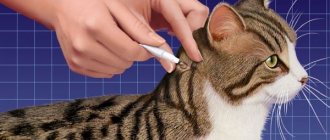Flea remedies for kittens
If you notice that your kitten is often itching or trying to bite something out of its fur, immediately examine your pet.
If you find fleas, immediately take measures to destroy them. There are the following ways to combat fleas in kittens:
- combing with a fine-toothed comb;
- washing the kitten with shampoo designed to remove parasites;
- applying drops to the kitten’s fur to kill fleas;
- Using an insect repellent collar.
But the treatment must be carried out in such a way as not to harm the kitten. After all, drugs intended for adults are not suitable for a baby. Let's try to figure out what to use without harming the kitten.
You need to be especially careful in selecting the method of killing fleas if the kitten has not yet been separated from its mother and is suckling milk. Indeed, in this case, the insecticide used, when licking the kitten, will enter the cat’s stomach, and subsequently into the milk, which can cause poisoning of the baby.
We wrote about how to remove fleas from cats, what means can be used for this and whether traditional methods can be used in other articles on our website. There you can also find detailed instructions on the use of drugs such as Lawyer, Inspector and Frontline.
Combing out fleas
The most gentle treatment that does not cause any harm to the kitten. Using a comb or fine-toothed comb, comb the fur, gradually separating all the strands. Select fleas found by hand.
A rather slow method that does not guarantee complete destruction of parasites. In addition, the cat will not remain an indifferent spectator.
She also catches fleas in the process of licking the baby's fur. This method will make the kitten’s life much easier until it reaches the age of three months, when it will be possible to treat it with preparations containing insecticides.
Bathing a kitten with flea shampoo
After combing, this is the gentlest way to remove fleas from your pet. Many shampoos produced for these purposes also care for the fur. An example is the “Clandestine” shampoo produced by the company of the same name (read about other Celandine products for removing fleas here). In addition to medicinal herbs, it contains insecticides in very low concentrations. Therefore, it can be used to wash kittens from the age of two months.
When buying shampoo, any veterinarian will ask about the age of your pet and tell you the most effective remedy. When bathing a kitten, it is best to follow a certain sequence:
- Add the recommended amount of shampoo to the water and stir until foam appears.
- Place the kitten in a container of water and thoroughly wet its fur, avoiding water and foam from getting into the eyes, mouth and ears.
- After waiting 4-5 minutes, rinse off the soap suds with clean, warm water.
- You can dry the wet fur with a hairdryer, but the best way is to wrap the kitten in a towel and hold it in your arms until it dries. In your arms, the animal will calm down and warm up faster, because not all cats tolerate bathing well.
The washing procedure should not be carried out too often, so as not to disturb the protective coating on the animal’s skin. To make the procedure safer, you can prepare your own shampoo.
- Boil 300 grams of soap grass in half a liter of water and add tansy or wormwood to the infusion.
- Add a few drops of any essential oil (mint, fir, lavender) to the resulting decoction to enhance the effect and better comb the coat.
- Store unused broth in the refrigerator for no more than three weeks.
Read more about shampoos for fleas in cats here.
Advantages and disadvantages of application
Flea shampoos are quite popular among cat owners. This is easily explained, because the funds have many advantages:
- ease of use;
- Can be used for cats of any breed;
- low toxicity compared to other agents;
- efficiency;
- additional positive effect on the condition of the coat.
Another advantage is that shampoos have virtually no contraindications, and when used correctly they are safe for your pet.
But the funds also have disadvantages:
- short period of protection (no more than 20 days);
- risk of an allergic reaction to some ingredients;
- the categorical refusal of some pets to participate in water procedures, which is why an attempt to wash them is unsuccessful, and in the worst case it ends in deep scratches for the owner and stress for the cat.
The disadvantages include the fact that cheap products are ineffective, and high-quality shampoos that give long-term results are expensive.
How to wash specific body parts
Follow our tips, and you will be able to easily accustom your pet to bath procedures:
- Wash my ears. We recommend reading a more detailed article on how to properly clean a kitten's ears. For this you will need dry cotton pads. Gently wipe the kitty's ear with them. If a little dirt still remains, purchase a special lotion from a veterinary pharmacy. Spread it on a cotton pad and wipe the skin. Or use ear cleaning liquid, which must be poured directly into the sink, and after the dirt comes out, wipe it with a dry cotton swab.
- How to wash a kitten's butt? In general, it is worth teaching your baby to clean himself. But, if you have not yet succeeded, then use a damp cloth or tampon. You can lightly spray such a place with water, then the cat will probably start licking it himself.
- Wash the kitten's face. For minor stains, a damp cotton pad will help. If spots appear on the chin, which in cats is very vulnerable to various types of inflammation, then use zoo shampoo for bathing.
- How to wash your spout. Only clean visible areas and use cotton swabs. A wet nose should be wiped with a paper napkin.
- How to wash a kitten's paws. After a walk or toilet, place the purr in the washbasin and lightly rinse the bottom of the limbs with warm water.
- Wash the kitten's eyes. Clean them using discs moistened with water. If a kitten has swollen eyes, then they should be wiped with a cotton wool soaked in black tea.
The best insecticidal shampoos
Examples of popular gels
The problem with parasitic insects can affect every pet, even domestic ones. Modern drugs allow you to completely get rid of pests in one procedure.
It is important to thoroughly rinse the product from the fur and not allow the cat to lick itself while bathing.
“Rolf Club” 400 ml – 215 rub.
Rolf Club
3. “Rolf Club” 400 ml – 215 rub.
One of the leading shampoos against fleas, lice and ticks in cats, with permethrin as an active ingredient. Can be used in kittens older than 12 weeks. The drug is applied to the animal’s body, avoiding the mucous membranes and ears, wait 5-10 minutes and rinse well.
Advantages:
- Effective from the first treatment
- Large bottle at low cost
- Consumes very slowly
- In addition to fighting parasites, it removes dirt well
- Deodorizes and refreshes
- The smell is not strong
Flaws:
- There are contraindications: cat pregnancy, lactation period, age under 3 months
- Individual intolerance
- Do not use if there are open wounds, damaged areas, or dermatitis on the body.
“Lugovoi” 270 ml – 180 rub.
Meadow Insecticidal
4. “Lugovoy” 270 ml – 180 rub.
An effective drug not only destroys parasites, but also affects metabolic processes, forcing the sebaceous glands to work actively, eliminating dryness of the epidermis. The active substances are permethrin and plant components from natural repellents. Contains lanolin.
Advantages:
- Low cost
- Spends sparingly
- Gets it right the first time
- Makes the coat silky
- Moisturizes the skin and coat
- Performs a gentle healing effect on the upper layer of the dermis
- Foams well even in hard and cold water
- Dogs can be bathed
- Easily and completely rinsed off
Flaws:
- Individual intolerance
- Contraindications: cat pregnancy, lactation period, age under 12 years
- May cause allergies
We build a house for a cat with our own hands. Interesting ideas and step-by-step instructions: from plywood, cardboard boxes, fabric. Drawings with dimensions (120+ Photos & Videos)
Composition and purpose
Flea and tick shampoo for cats is designed primarily to kill parasites and prevent re-infestation. But in addition to the main task, shampoos perform several more functions:
- cleanse skin and coat;
- help maintain freshness;
- strengthen the coat and make it softer;
- treat some skin diseases.
The most common active ingredients in medicinal shampoos are:
- pyrethrin is a natural insecticide;
- pyrethroids – synthetic analogues of pyrethrin;
- phenothrin;
- etofenprox.
These substances act not only against fleas. They cope with lice, lice and other parasites.
The preventative flea shampoo contains essential oils (wormwood, lavender, tea tree, eucalyptus, thyme, etc.) as active ingredients.
How often to wash
There are a wide variety of, and sometimes conflicting, recommendations on how to wash a cat and how often it should be done. Some experienced owners advise bathing their animals once a month. Others believe that this is too frequent and advise resorting to water procedures no more than twice a year. In this matter, much depends on the breed of the pet, the condition of its coat and the health of the animal.
If the cat has luxurious long hair, then you can bathe the beauty once a month. An animal of a long-haired breed will not be able to cope with maintaining the coat in proper form on its own. If the cat has short hair, then it is advisable to carry out water procedures once every 2 months.
Owners of so-called hairless breeds are interested in how to wash their cat. Cat breeds such as Sphynx, Rex, Bambino need bathing even less often than their long-haired counterparts - once every 3 months.
Cases when a cat must be washed:
participation in exhibition events;
when the animal is dirty, especially if it is stained with paint, chemicals, building materials, etc.;
in case of severe shedding in order to prevent the development of hair balls in the animal’s stomach.
The owner should understand that in addition to dust and dirt particles, microbes also accumulate on the wool. Therefore, the animal should be washed regularly, and not occasionally.
We recommend reading about how to train a cat to use a scratching post. You will learn about the types of scratching posts, how to choose the best option for your pet, and how to make the device yourself. And here is more information about why cats have bad breath.
How often can you wash your kitten with flea shampoo?
Fleas do not always die the first time, even if you wash your pet thoroughly. Insects can hide in hard-to-reach places, and some of them return after swimming.
The frequency of washing with flea shampoo depends on the brand of the product; this information is usually indicated on the packaging. Most often, it is recommended to bathe the baby again no earlier than 10 days after the first treatment. Then you need to pause for at least 2 months.
Important. If after treatment the kitten develops irritation or other allergy symptoms, you cannot wash it with the same shampoo again. You need to take your pet to the veterinarian and, together with a specialist, choose a new drug.
Even a kitten that does not go outside can get fleas. Parasites enter the house:
- together with people on clothes or shoes;
- from basements, especially if they are favored by homeless animals;
- from neighbors who have infected pets.
If your baby often itches and bites himself, you need to examine him carefully. This behavior is the first sign of the presence of parasites.
To completely get rid of insects, you need not only to wash the kitten, but also to treat the bed, carpets, upholstered furniture and secluded corners of the apartment with anti-flea agents, where eggs and larvae of parasites can remain. After all, if fleas begin to multiply en masse, it will be several times more difficult to destroy them.
How to wash a cat if there is no special shampoo
For regular care of animals, special products are needed. They are less aggressive in composition than regular shampoos. It is best to wash the cat with warm water and beaten egg yolk. If that doesn’t work, you need compounds with PVA.
Let's discuss what to choose from what is in the bathroom.
Regular soap
It is not recommended to bathe a kitten with soap with a strong fruity or floral aroma. Bath, pine, and baby soap are preferable. Experienced veterinarians do not advise excessive soaping of the animal.
You shouldn't bathe your pet too hard. He must have natural protection.
Baby shampoo
Products used to wash children under three years of age are hypoallergenic. They contain less of all kinds of synthetic additives and more natural ingredients. But you can’t get carried away with them either.
The product is pre-diluted 1:3 and foamed well. And then the kitten is treated with foam. You need to carefully clean the face.
Phrases like “washes without tears” are a marketing ploy. When foam gets into the eyes of animals, conjunctivitis develops. The small pet will become restless. Ears are a no-go area. They are cleaned with ear sticks with water, lotion or saline solution.
Regular human shampoo
Some owners use human shampoo to care for their pets, and do this regularly. Veterinarians strictly prohibit doing this. The secretion of fatty glands is disrupted, the skin suffers, and the structure of the hairs changes.
Allergic dermatitis and other skin diseases are possible. Immunity weakens. After washing, cats get sick more often and can get pneumonia.
The soap composition is made by diluting the shampoo with water, increasing the volume at least five times. In this case, it will be possible to protect the cat from the consequences and reduce the risk of developing skin diseases.
Tar shampoo or liquid soap
Tar is an excellent folk remedy for skin irritation. Liquid soap or tar shampoo is a good insecticidal remedy for blood-sucking insects.
If your pet constantly scratches itself with its paws or bites something out of its fur, it may have fleas. Try washing it with tar soap. This primitive method is used in folk medicine.
Rules of application
Fleas in a person's head die very quickly if you apply and wash off the product correctly and do not forget about precautions. It is worth taking note of the following recommendations:
Up to 60 ml of the drug is usually consumed per person’s head, depending on the length and thickness of the strands. All medications are applied either with a cotton swab or with special gloves: it is strictly forbidden to take them with bare hands
First, the product is applied to some base, and then carefully distributed over the entire head. After application, the head is covered with a plastic cap and wrapped with a towel on top. If shampoo accidentally gets into your eyes, rinse them immediately with plenty of water. All products should be used with open windows and, if possible, in an open space: this way there will be no risk of poisoning with toxic substances, which are one way or another included in all medicinal preparations. After washing, it is important to comb thoroughly with a fine lice comb.. Interesting! There is an opinion that you can walk an animal in the cold and the fleas themselves will freeze
At what temperature do fleas die? Parasites are distinguished by their rare vitality: even at -20 degrees they only fall asleep, lose the ability to reproduce and move, but in the warmth they come to life again and begin to jump with the same energy
Curious! There is an opinion that you can walk an animal in the cold and the fleas themselves will freeze. At what temperature do fleas die? Parasites are distinguished by their rare vitality: even at -20 degrees they only fall asleep, lose the ability to reproduce and move, but in the warmth they come to life again and begin to jump with the same energy.
Which to choose
The selection of the product is carried out depending on the needs of the animal. If, in addition to fleas, the animal’s fur is dull and constantly falling out, it is necessary to ensure that the composition includes sulfur or its derivatives.
For itching and dry skin, choose shampoo with herbal ingredients and essential oils.
It is better to use professional lines of care products - they are the most effective and are better tolerated by sensitive animals.
Preparations with antiparasitic properties, including shampoos, are recommended for use at the first manifestations of fleas:
- the animal becomes restless and constantly meows;
- cats constantly scratch and lick the bite sites due to severe itching:
- formation of wounds, redness, scratches on the animal’s skin;
- the presence of flea feces, dried drops of blood on the animal’s fur;
- with severe damage to the skin, the color of the coat changes: it acquires a brown tint and becomes duller;
- Often a person can detect parasites himself, during an in-person examination.
Flea shampoos have a number of advantages over drops and sprays with a similar effect:
- ease of use;
- budget cost;
- suitable for newborn kittens, pregnant cats;
- the absence of aggressive soap, which dries the skin and causes hair loss;
- the possibility of using zoo shampoo when treating animals with sensitive skin;
- insecticide with caring properties;
- products with a prophylactic composition can be used several times a month. The treatment has to be repeated again after the cat has been outside.
The best flea shampoos for cats are hypoallergenic. Animals are more sensitive than humans. The presence of aggressive detergent components can not only eliminate fleas, but also negatively affect the well-being of the pet.
TOP 10 best shampoos for cats
There are many flea shampoos that differ in cost, composition and effectiveness. However, it is recommended to choose trusted and well-known manufacturers who have good reviews from veterinarians and really help get rid of parasites.
Shampoo Beafar Bio (Beaphar)
One of the most effective flea shampoos for cats is Beafar. The average price of a product is 350 rubles. The active ingredient of the drug is dimethicone, it deactivates fleas, as well as ticks and other insects by gluing their limbs and enveloping the body of the pest. Beafar fights not only with adults, but also with larvae. The product is produced in the EU and the Netherlands.
Rolf Club
This flea shampoo for cats is designed to combat and prevent the manifestations of external parasites. The country of origin of the product is Russia. The average price is 300-350 rubles.
The drug does not cause allergic reactions or skin irritations when used in the correct dosage according to the instructions.
BIO-GROOM
The manufacturer presents a wide line of flea shampoos for kittens, as well as for adult cats, including hypoallergenic products, which contain only natural ingredients. The average price of one product is 1000 rubles. Country of manufacture: USA.
Mr. Kiss
One of the effective means to combat parasites. Products are presented for cats with long and short hair, as well as hairless pets. There is also a line for kittens. The average cost is 200-250 rubles. The composition includes biotin, which allows you to heal wounds faster, relieve inflammation from the skin, and strengthen the hair roots.
Phytoelite
Flea shampoo for cats, called Phytoelite, works due to the addition of the insecticide permethrin. Used to get rid of lice and lice. In addition, the composition includes repellents - wormwood and celandine, the smells of which repel insects.
At what age can the product be used? It is suitable for kittens from 8 weeks. The average price is 150 rubles. According to reviews from pet owners, this product is one of the best flea shampoos for cats.
Lugovoy
This cat flea shampoo is used for cats and kittens after 12 weeks. The average price of a product is 200 rubles. The active substance is deltamethrin, as well as repellents: chamomile, calendula, coltsfoot.
Due to the auxiliary components, wounds on the cat’s body heal faster and the condition of the coat improves.
Celandine
The active ingredient contains permethrin, excipients - herbal fragrance, vitamin E. The products are presented for kittens and adult cats. The country of origin of the product is Russia.
The average cost is 100 rubles. The product has a high rating, however, it often causes allergies; the dosage should be strictly observed, since the concentration of the insecticide is quite high.
BioVax
The active ingredient is lanolin, which effectively cleanses the skin and coat of parasites, while softening and relieving irritation. The average cost is 80-100 rubles. Tea tree oil and chamomile are used as repellents. The product is used to get rid of fleas, lice, ticks, and lice.
There is a line for kittens - the preparations contain herbal ingredients, including chamomile extract. The manufacturer of the product is Biosphere. The product is manufactured in Russia.
Dana (Api-San)
Dana is an effective shampoo that is used to kill lice, lice, and fleas for cats and dogs. Promotes healing of wounds from fleas and ticks, relieves itching and irritation, eliminates foreign odors.
The drug is contraindicated for kittens under 3 months of age, sick animals, and lactating females. To prevent re-infestation, it is recommended to treat animal bedding with the same preparation and rinse thoroughly. The average price is 100-120 rubles.
Barsik
The average price ranges from 30 to 60 rubles. 0.2% fenthion is used as an anti-parasite agent. According to reviews, the shampoo is the least effective. The insecticides included in the composition lead to severe health complications for cats; an overdose of the substance leads to the death of the animal.
Shampoo "Bars"
An effective remedy for fleas, lice, lice and ticks. Often frees the animal from parasites with one application. The composition includes extracts of medicinal herbs that eliminate itching, irritation, and relieve animals from dandruff. This flea shampoo for cats and dogs is approved for use on kittens and puppies.
After washing, the coat is easy to comb and becomes beautiful and fluffy. Bars shampoo also has a drawback: the drug irritates the mucous membranes. When washing, you need to carefully ensure that the foam does not get on the animal’s nose, mouth and eyes. Not recommended for use in pregnant cats.
Processing rules
In order for the procedure to bring the desired result and not cause unnecessary problems for the animal owner, several nuances need to be taken into account:
- Choosing a location. If the level of parasite infestation is high, fleas will move from the animal to surrounding surfaces. Therefore, it is recommended to carry out the procedure outdoors or indoors where there are no other pets. When this is not possible, you should at least protect yourself by treating the room with a strong agent in advance. This measure will reduce the likelihood of fleas spreading.
- Cloth. To avoid parasite bites, you need to cover the most vulnerable parts of the body at this moment.
- Processing items. As a rule, flea eggs and larvae are found on surfaces with which the pet is most often in contact. To prevent re-infestation, you also need to apply special products to them, and you should place a bag filled with pine sawdust under the cat’s house or bed - this will repel parasites.
- Animal processing. Fleas tend to spread to other inhabitants of the apartment. Therefore, if the owner has several pets, he will need to take preventive measures, which involve the use of means to combat parasites even on healthy animals.
The washing process itself should not cause difficulties, because if the kitten does not like water, it will be easy to hold it together. The main thing is to carefully read the instructions for the shampoo, especially highlighting the exposure time of the product and the interval before the next treatment. Otherwise, the general recommendations are:
Place the kitten in a plastic basin. It is advisable to do this in a similar container, since due to the small size of the animal, it will be a little difficult to process in the bath. However, this option is also allowed, but the bottom of the tub will have to be covered with a rag so that the pet’s paws do not slip on the enamel. Thoroughly wet the kitten's fur and lather, starting from the neck area
This is important because this way the parasites will not move from the body to the face. Leave the soap mass for the time period specified in the instructions. The kitten must be restrained so that it does not lick the product
The main thing is not to be afraid of causing pain to the animal and to be careful. Rinse off the shampoo (until there is no foam). At the same time, it is worth manually picking out fleas from the kitten’s face, if any remain on it.
To increase efficiency, wet wool should be combed with a fine-tooth comb. This step may slightly spoil its appearance, but will have a positive effect on the result.
If your animal becomes irritated after applying the shampoo, the product should be washed off immediately. To avoid trouble, you should consult a veterinarian. It is also recommended to do this if the owner is not sure of the choice
Such precautions will allow you to get the best effect from the treatment and protect the animal.
How to wash a kitten if there is no special shampoo?
If there is no special shampoo, you can wash (if absolutely necessary) the cat with just water. It will perfectly wash away dirt without causing damage to the skin. Shampoos are also not suitable for other types of animals.
So, how often can you wash your kitten with shampoo? The less often you need to wash your pet, the better. Under any circumstances, this procedure can be repeated no more than once every 3-4 months, the best option is 2 times a year (as needed).
If we are talking about therapeutic bathing (for dermatitis, allergies, lichen), things are different: you need to wash the kitten as many times as the doctor prescribes.
Also an exception are exhibition animals - they are bathed immediately before the exhibition.
If you plan to take the animal to exhibitions, you need to accustom the kitten to water in advance so that in the future it experiences less stress. Some advise starting as early as a month, but it’s better to wait until two or three.
It is important to remember the following nuances:
- You cannot bathe a kitten for several days after vaccination. The British are bathed differently (like bathing a British kitten).
- 3 days before and 3 days after treatment for fleas (how to wash a kitten for fleas) and other parasites, you should also not bathe.
- It is best to wash a kitten when it adapts to its new place of residence - this is approximately 2-3 weeks.
The sequence of actions when bathing is as follows:
It is important to comb the animal before bathing if it has long hair. Wet tangles cannot be untangled and can only be gotten rid of by cutting them off.
If your kitten gets stressed while brushing, give him time to calm down before putting him in a bowl of water. You should not bathe the kitten immediately after eating - you need to wait 2-3 hours. You should fill the bath with warm water. If it is a kitten, a basin will be enough. The water should be slightly warmer than body temperature.
The kitten will feel more confident if you put a towel on the bottom - the paws will not slide as much. The entire bathing procedure should take no more than 15 minutes. If the kitten is acting very restless, you can try to divert his attention to his toys: balls, rattles, mice. You should wash the kitten carefully so that the shampoo does not get into the ears, eyes, or nose. You should also be careful with water - if it gets into your ears, it can cause an inflammatory process (otitis media). To protect them, you can use cotton balls by simply pressing them lightly into your ears. You can also make something like a shower cap out of cellophane. If this makes the kitten panic more, you should do without them and just carefully monitor the ears. After the shampoo has been thoroughly rinsed, the kitten should be wrapped in a towel and kept warm until it dries. It is advisable to comb the kitten if it has long hair. Treat the kitten to something tasty to smooth out the impressions of the “torture” and develop pleasant associations in it.
Excessive dirt in the ears may indicate problems with the ears, including a parasitic disease - otodectosis. This disease is caused by a microscopic mite and is often found in outdoor kittens. The diagnosis is confirmed by microscopy of earwax.
If a tick is detected there, appropriate treatment is prescribed, and the doctor will show and tell you how and with what to properly clean the cat’s ears, as well as what to treat. Once the kitten gets rid of the tick, regular cleaning can be stopped.
To avoid lacerations on your hands, you can trim your nails first. It is advisable to not perform this procedure right before bathing, as cats become very panicky during nail trimming.
If the panic from bathing is superimposed on the panic from trimming nails, we will not get anything good.
If the kitten is shivering for a very long time and it is clear that he is cold, you can dry him with a hairdryer (especially if the apartment is cold), but use only the cold air mode.
These simple nuances will make bathing safe for the kitten.
Useful video
Check out visually how to wash a kitten for fleas!
When purchasing a purebred animal, be prepared for the fact that it requires more careful and expensive care. This statement especially applies to long-haired pets.
- Related Posts
- At what age can British kittens be bathed? How to wash properly for the first time?
- How to wash a kitten if there is no special shampoo? Is it possible to wash a kitten with regular shampoo?
- We bathe a small kitten at 1, 2, 3 months. Is it possible to wash a kitten?
Visually see how you can bathe a kitten with regular shampoo.
Today you found out how many times you can wash a kitten with shampoo and whether you can wash a kitten with baby shampoo and regular shampoo.
- Related Posts
- We bathe a small kitten at 1, 2, 3 months. Is it possible to wash a kitten?
- At what age can British kittens be bathed? How to wash properly for the first time?
- How to wash a kitten with flea shampoo? How often and with what should I wash my kitten for fleas?
The following recommendations will help you avoid health problems in your pet:
- Postpone water procedures for at least two weeks after vaccination.
- After castration, at least 10 days must pass.
- You should also not wet the kitten’s fur for three days before and after flea treatment. Although, at the age of up to 3 months, not all parasite remedies are allowed.
- There is no need for daily washing. As a result, the protective fat layer is washed away and the quality of the coat suffers.
- It is advisable to repeat water procedures no more than once a season, starting from the age of 3–5 months.
- If the kitten is wayward and likes to scratch, then carefully trim its claws before bathing.
- Wait 2-3 hours after feeding.
- It is worth bathing a cat of any age as soon as possible if it is taken from the street. But it is undesirable to accustom a domestic kitten to washing before it adapts to its new family. This takes about 2–3 weeks.
Bathing cats needs to be taken seriously. To avoid problems with age, it is better to accustom the kitten to washing before the age of one year, since an adult animal will desperately resist. By the way, for such alarmists they came up with dry shampoo that does not require contact with water. If necessary, you can bathe the baby completely, but not earlier than 2 weeks after birth. Still, it is better to postpone the procedure until the cat reaches 2–3 months of age.
bathing /
How often to wash
For most breeds, 1-2 baths per year will be sufficient. The frequency of the procedure depends on the type and length of the coat, as well as the condition of the skin. There is a concept called “animal fur”. This means that the hair has a structure similar to that of a wolf or wild dog. These are usually large dogs with hard, thick hair.
Decorative breeds cannot boast of durable and strong hair. Their thin coat often gets dirty and requires careful care. For example, a Yorkshire Terrier needs to be washed every 7-10 days. For medium and large breeds, it is enough to wash 1-4 times a year.
Domestic dogs rarely get dirty enough to need to be washed. Usually, wiping the paws and belly with a damp towel or napkin is enough.
If your pet is very dirty or it’s time for a scheduled bath, you need to carry out the procedure correctly. It is better to wash dogs in the bathroom, in warm water. Typically, cosmetics for hair care are in the form of a concentrate, so the shampoo is first diluted in water and the pet is washed with the resulting foam. The shampoo is applied to a damp body. After this, the owner should soap the dog well, starting from the back and sides
Particular attention is paid to intimate places. To protect the ears, you will have to plug them with cotton balls or put a bathing cap on your pet.
After the shampoo has been thoroughly rinsed, apply conditioner or conditioner. It is washed off after a few minutes.
Dog wash products must be chosen very carefully. They must be appropriate for age, breed and coat type. If you wash your pet with human shampoo or soap, you can damage the fur and skin.
Features of the life activity of fleas on the skin of animals
Cats' thick fur with an insulating undercoat traps warm air directly against the skin. A favorable temperature environment is created for the life and reproduction of fleas.
If your cat scratches its ears frequently, this may be a sign that it has fleas.
Fleas are attracted to body heat, vibrations from movement, and the smell of the cat. Dormant larvae quickly “come to life”, quickly turn into fleas, and then jump on the animal.
The presence of fleas in a cat is confirmed by the following symptoms
Fleas are the most common type of flightless blood-sucking parasite.
- Dullness and hair loss.
- Scratching and excessive licking of the fur (it is constantly disheveled) is a sign of flea dermatitis. A flea allergy is a reaction to a substance in flea saliva that prevents blood clotting.
- Numerous peeling flakes of skin, sometimes with a bloody stain around the edges.
- Intraepidermal hemorrhages. If you spread the fur with your hands and look at the condition of the skin, you will see distinct dark red lesions on a white background. In advanced cases, dark red scabs appear, the skin becomes covered with cracks and ulcers.
- A specific sign of fleas is the presence of insects or their metabolic products in the form of black spots (dots) on the skin. More often they are localized in the area of the hind legs (the so-called “panties”) and the back.
Flea bites cause pain and itching to an animal.
Additional pathogens and infections carried by fleas
- Yersinia, salmonella (affect the intestines);
- pseudotuberculosis;
- tularemia and brucellosis (especially dangerous infections);
- tick-borne encephalitis virus;
- trypanosomes.
Is it possible to wash a kitten with regular shampoo?
So, is it possible and how to bathe a kitten with regular shampoo? It is not advisable to use shampoos that we use ourselves (even for children) to bathe cats for several reasons:
- The structure of cats' skin is very different from ours.
- Their skin pH is higher.
- You need to wash your cat with a gentle shampoo that will not completely wash out their protective layer of skin. If it is completely washed, it will take a long time to recover, and the cat will be susceptible to hypothermia, colds, and infections for a long time.
- After bathing, the kitten must be kept warm. Small kittens (how to wash a small kitten) are especially at risk of catching a cold after bathing.



